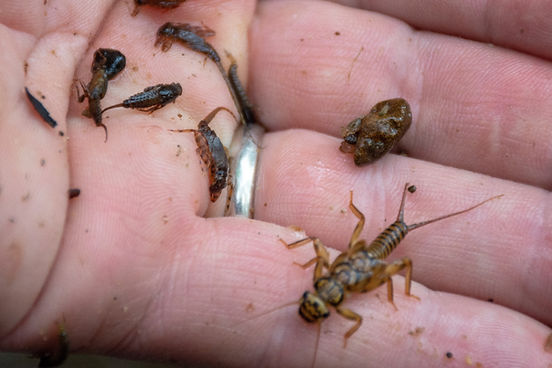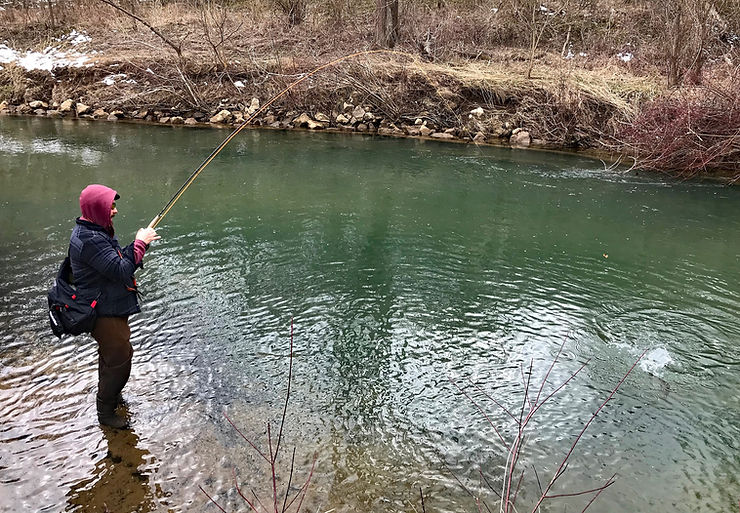Choosing and Using the Right Fly

The right fly can produce a banner day. The wrong fly can leave you fishless and frustrated.
A few years ago, I was having a rough outing on Buffalo Creek Delayed Harvest in Butler County. Buffalo Creek is a mid-sized stream with a strong early spring flow. The stream had just been stocked two days earlier, so I knew it was full of trout. I attributed their lockjaw to them getting acclimated to their new residence and the cold weather conditions – ice along the banks and daytime highs in the low 20s.
I remember very clearly that I was using a Prince Nymph, and then a Pheasant Tail, a Copper John, Mop flies, a variety of egg patterns, and so on and so forth until I’d exhausted pretty much all of the options in my fly box. Not even a bump from a trout for almost two hours. Freshly stocked trout weren’t supposed to be this finicky.
Finally, I got down to that dusty corner of my fly box where the sunshine seldom reaches, the one with the forgotten, misfit flies I’d tied or picked up somewhere along the way. I plucked out a flashy little number with an olive body and no name…and caught three trout on my next half dozen or so casts, and then two or three more in the next hour and a half before I had to leave. Later, back at the truck, I think I figured out why I’d suddenly found success, but more about that in just a little bit.
This example would seem to stress the importance of fly selection. Although it’s true that there are times the trout will focus on one insect species or color almost to the exclusivity of everything else, I believe these instances are much rarer than many believe. Sample the stomach contents of any trout and you’ll likely find a plethora of insects ranging from stonefly nymphs to mayfly nymphs to caddis pupa.
The exception, of course, is during a hatch when trout will key on specific insects, and sometimes even specific stages of that insect while they’re hatching, such as the emerger rather than the dun, etc. But for general nymphing during non-hatch periods, trout tend to be more opportunistic than selective. When I arrive at the stream, and I’m trying to determine what fly to tie on first, I follow a few simple steps that help get me started.
Know the Stream
More specifically, know the bugs in the stream, especially the insects you’re likely to find at that time of year. For instance, if I were fishing a limestone stream known for a good Blue Winged Olive hatch in the winter, an olive nymph in sizes 18-22 would be a natural starting point even if the hatch never materializes that day. However, knowing that these particular nymphs are active on the stream bottom this time of year, I can deduce that trout spend a good portion of each day feeding on them.

A variety of nymphs collected from a trout stream. Turning over a few rocks will help you learn which insects are most abundant where you fish.
If a stream has a great March Brown hatch, then from mid-May on, I know to have a few March Brown nymphs in my box. If it’s Green Drake time on Penns Creek or Yellow Creek, then I’m definitely going to have those nymphs handy when I fish there.
Hatch Charts and Samples
Before fishing new waters, familiarize yourself with hatch charts for that particular stream. There are so many online resources available nowadays that you can find hatch dates for almost anywhere you want to fish. Use these to your advantage. They can help you narrow down fly selection to a handful of patterns.
If you want an even more accurate reading of what the fish might be feeding on, break out the seine and take a quick sample. I usually carry a small fish tank seine with me in my pack. If I’m on the fence about what to tie on, I wade in downstream of where I want to fish and try to get a few samples of whatever insects are in the water.
Confidence Patterns
A final component to fly choice – but certainly not the least important – is the idea of confidence patterns. We all have them, and I’ve learned over the years to never underestimate their value. Part of catching a fish is having confidence that the fly you’re using will indeed be effective. I guess you could call this the “black magic” part of fly fishing.
I know guys who use only 2-3 different patterns all season long and catch fish everywhere they go. I also know fishermen who have boxes and boxes of patterns and do everything they can to figure out exactly what they trout are keying on, and yet they often get out-fished by the generalists. Sometimes fly fishing just doesn’t make sense.
Presentation
How the fly is presented is as important as the fly you’re using, and figuring out the right presentation for the situation is a combination of personal experience, observation, and experimentation. Basically, if you’re not catching fish, try something different. The most common adjustment I usually make is the speed of the drift. A lot of times, I’m not catching as many trout as I could because I’m simply fishing too fast. This means slowing down my presentation, but also slowing down myself and forcing myself to be a little more thorough and deliberate about how I work the water.
I’ve also experienced times when trout will hit on the downstream swing rather than during the drift. Other times, I’ve had to add a split shot above the fly to get deeper and fish slower. A few years ago on the Clarion River, the only way I could seduce a strike was to let a black Wooly Bugger hang in the current directly downstream of my position, and then retrieve it literally one inch at a time – but oh, the trout I caught that day! So before exhausting every option in your fly box, try a change in presentation first.

The right fly can mean the difference between a good day and a great day on the water.
Weather Conditions
Weather conditions also play a huge role in how trout feed, and therefore, how you need to present the fly to trigger strikes. Back to that day on Buffalo Creek. Frigid water temperatures often mean sluggish fish. Combined with below-freezing air temperatures, this can result in very short feeding windows. And that’s what I think I encountered that day on Buffalo Creek. The catching picked up during the warmest part of the day when the sun peeked out from the clouds and the water temp warmed up a couple of degrees. In the world of trout, an increase of only one or two degrees is a big deal.
Can I be certain that success that day was a result of an opening feeding window and not because I’d finally found the magic fly? No. But I do know this. As I was taking off my waders at the truck, another guy was leaving as well, and we discussed our experiences that day. He said, “I didn’t catch anything until about 2 o’clock, and for about an hour there they opened up. I wouldn’t have caught a damn trout if I hadn’t put on my lucky fly.”
“What’s your lucky fly?” I asked. He showed me a size 14 Blow Torch, which is a European jig-style nymph with a soft hackle and a hot spot.
So there you have it. Two guys fishing the same stream, each of them experiencing the same conditions, catching trout at virtually the same time of day, but each one using completely different flies. Like I said, sometimes fly fishing just doesn’t make sense.
Sign up for the Dark Skies Fly Fishing e-newsletter
It's free, delivered to your inbox approximately three times each month. Your information is always kept private and used for the sole purpose of keeping you up to date on blog posts and specials in the online store.
Sign Up Now